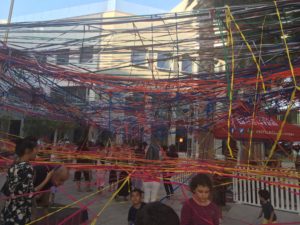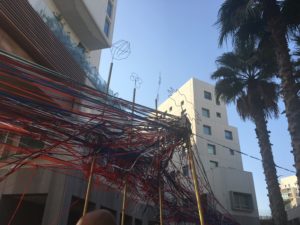Wristbands, all types of wristbands. I had a plastic box divided by different compartments in which I kept elastic or colored threads, thick or thin, glowing stones, and tiny figures. Tangle reminds me of the passion of observing my threads, trying new challenging patterns after getting inspiration in YouTue videos, unravel them when entangled, and wondering what to create with them and other materials. I cherished the satisfaction of wearing my wrists full of color or observing my mom’s smile every time I gave her one of my creations. In this essay, I will use my wristbands’ experience and the book “Design for Play: A guide to creating successful play spaces” by Aileen Shackell, Nicola Butler, Phil Doyle, and David Ball to discuss my observation of Tangle and my interaction with it.
As a theatre company that perceives children as participants and collaborators rather than as merely part of the audience, Polyglot came to New York University Abu Dhabi to create a massive weaving play space. While being bounded by white fences, the space engages children and their families with hundreds of colored elastic tied to a set of poles distributed in the main outdoor area of our campus. By closely observing one of the first exhibitions, I saw how participants were grouped right at the space portal and given a short introduction by four men and women dressed in colorful and loose pants, suspenders, and white shirts. They smiled and looked extremely excited about what was about to come. Inside the space, there was another guy with an ukelele and a keyboard, creating sounds that you wouldn’t normally hear in daily life. The guy played a song that I might have heard sometime in my childhood combined with low and high-pitched sounds. Each participant was given either a yellow or red ball of elastic and the single instruction to tangle it around the space. Subsequently, participants crossed the portal and walked around trying to intertwine their elastic around the poles and/or other elastic.
As my hand-made wristbands presented a possibility to test the limits of my capabilities, by having a ball of elastic in hand and a colorful and unknown world ahead, children were introduced to a unique and unusual challenge. Some parents were confused and probably uncertain about the potential dangers of the new space. Shackell et al. highlight the importance of risk-taking in play, describing how taking new risks and challenges is an essential part of growing up and providers need to understand and account for that in play experiences. It seemed for my observations and our class talk with the artists that Polyglot understood this well. Although they mentioned having a meticulous design process, and never experiencing an accident, they aspire for spaces in which children can explore worlds that as in the real one, have risks and challenges. In Tangle, Children first faced the challenge of securing one end of the elastic ball and deciding where to go until they finish the creation of their very own path. This resulted in varied difficulties for children, as some received more help from their parents, were older, or weren’t obstructed by other children. Their motion, creative, and social capabilities were in this way tested in the framework of Tangle, and they were able to observe their achievements by identifying their elastic’s trajectory in the network.

The nature of having one single instruction gave children another challenge: deciding what to do next. For me, this is one of the most valuable aspects of Tangle, as children can interact with a space in which they can experience freedom and the process of decision-making. Whatever they do is up to them. As such, according to Shackell et. all, a successful game experience is based not only in enabling the creation of challenges and test of skills but also in offering physical movement, stimulating the five senses, fostering social interaction, and allowing the manipulation of materials. Perhaps not having a definite “goal” made adults feel lost, but children were excited. Some tried to finish the first task as soon as they could to finally “play” -weren’t they playing before? Although fenced, Tangle provided a large space for children to move around freely. Not only move but move in any way they wanted. Along with the huge colorful and abstract structure, the sound, and the entrance portal, artists played an important role in transforming what is usually the entrance of the university in a whole new world with different rules than the ones of the “normal” world.
They could interact with the exhibition’s materials as well as with their parents, the artists, and other children, and this interaction was not the same as the one with the outside world and its people. By seeing the artists dance around, make funny faces and sounds, and using the elastics as jungles or ponds where they could fish and explore, children understood how the world of Tangle could be anything they want it to be. I saw one girl trying to climb the net of elastic with the help of her mom, a group of children crawling with one of the artists like snakes, a boy running from an artist that was trying to chase him, and even another older boy trying to get to the microphone. Maybe they could do all these things outside of Tangle, but in this world everything they did was different. Where else have they been allowed to tangle other children with their elastic, run as fast as they wanted, be their favorite animals, and scream as loud as they could? Everything while being below and in between a colorful world of elastic that was created by them, Polyglot, and other members of the community.
Like my wristbands, Tangle was described by the media as an “artwork”. If we consider “art” as something that is “created” and has a particular purpose, I think “Tangle” was indeed an art piece. The successful play experience described above was created by different choices. Why colored elastics? Why an open space? Why artists dressed up in a funny way? Why pulling the new elastic up every time a session finishes? What is the purpose of creating a giant network of elastic that becomes different with every participant? From the design process, it seems there have been efforts to guide participants to live a transformative experience. As the world of elastic changes continuously and is experienced differently by the participants, the outcomes of the experience changes with each session and person.
Overall, I think Tangle is a world that disrupts public space to turn it into a large playground. This playground allows for play to happen thanks to the world’s abstract form, the artists’ energy, and the imagination of the participants. In his book, “Play Matters”, Miguel Sicart argues that playgrounds are spaces of play that lend themselves to a type of play but do not impose a particular play activity, purpose, or reward. The best wristbands I have done were those in which I just played with threads and figures without thinking of a particular outcome. As such, Tangle’s world allows for a play of imagination and interaction with the space and other participants. However, it does not have a specific reward or purpose for the experience. I think that’s exactly what makes Tangle so great and fun, the fact that it can be whatever you want it to be, and you can be whoever you want to be in it.






